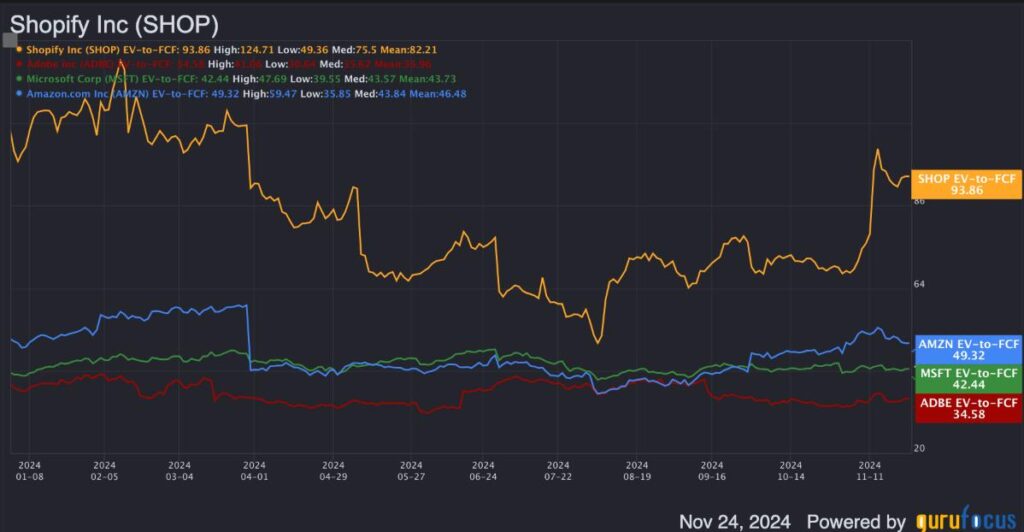Shopify, the e-commerce platform renowned for empowering businesses of all sizes, presents a valuation narrative suggesting it is moderately undervalued. With a discernible margin of safety at 14.7% and a projected compound annual growth rate (CAGR) of 11% in its enterprise value over the next 15 years, the stock constitutes a compelling long-term investment opportunity. Despite the formidable promise originating from the burgeoning small and medium-sized business (SMB) sector, as well as the creator economy, Shopify faces notable risks amidst increasing competition from established tech giants venturing into the creator space. Nonetheless, with the creator economy expected to transform and grow significantly, Shopify’s strategic positioning directly aligns with these trends, establishing it as a favorable candidate for investors with a long-term perspective.
Shopify’s operational framework is designed around facilitating a seamless e-commerce experience for businesses large and small. The platform’s robust suite of tools—ranging from website building and product management to payment processing—positions it as a key player in a sector increasingly reliant on digital sales. A substantial opportunity lies in its focus on the creator economy, evidenced by the advent of low-code/no-code tools that allow creators and small businesses to easily establish functional online stores. With the global creator economy forecasted to swell from $191 billion in 2025 to a staggering $528 billion by 2030, Shopify stands to gain from these tailwinds. Moreover, North America currently commands 40% of this market, further amplifying the potential for Shopify as it continues to cater primarily to the needs of small merchants, who generated 71.8% of the company’s revenue in its latest quarterly reporting.
As artificial intelligence (AI) and automation evolve, significant changes in labor markets are anticipated, potentially displacing millions of jobs and leading to a greater influx of independent creators and small businesses. This creates an expansive new customer base for Shopify. Research indicates that up to 300 million jobs could be automated shortly, suggesting an unprecedented surge in creators transitioning from traditional employment avenues. This dynamic situation hints at a symbiotic relationship between the acceleration of the creator economy and Shopify’s growth, especially as shifts toward universal basic income (UBI) may increase disposable incomes and spur spending among newly established small business networks.
To scrutinize Shopify’s long-term growth potential, I employed a 15-year discounted cash flow model, utilizing a conservative revenue growth estimate of 15%, based on the December 2024 consensus revenue of approximately $8.79 billion. This approach anticipates Shopify generating around $71.6 billion in revenue by December 2039, transitioning from a high-growth model into a stabilized cash-generating entity. By applying a terminal free cash flow margin of 30%, reflective of mature software-as-a-service (SaaS) companies, the projected free cash flow reaches approximately $21.48 billion. Furthermore, employing a conservative terminal enterprise value-to-free cash flow ratio of 30, the anticipated enterprise value for 2039 stands at $644.34 billion, signifying a notable upward trajectory relative to Shopify’s current enterprise valuation of $134.39 billion.
Despite the optimistic outlook, it is crucial to heed the competitive landscape surrounding Shopify. Major rivals like Amazon and WooCommerce are perpetually enhancing their offerings, which could pose a threat to Shopify’s market share. The entry of these larger players into the creator economy sector presents a challenge, especially as they leverage substantial resources for better integration with social platforms and supply chain infrastructures—critical components of e-commerce. Moreover, the creator economy’s dependence on discretionary consumer spending renders it vulnerable to economic fluctuations such as recessions or inflation. In particular, operators in this sector—including smaller businesses—face elevated failure rates during economic downturns, thus impacting Shopify’s revenue, especially from its Merchant Solutions, which serves a significant portion of small merchants.
The company’s recent Q3 performance underscores its resilience despite these risks, revealing a robust 26% year-over-year revenue increase. This marks Shopify’s sixth consecutive quarter of over 25% growth, aligning with a surge in free cash flow by 53% year-over-year, indicating enhanced operational effectiveness. The optimistic forecast for Q4, projecting continued strong revenue growth, bolsters the narrative that Shopify remains on an upward trajectory. The strong financial results highlight Shopify’s capacity to capitalize on the potential growth within its core markets, corroborating the assertion that its stock is undervalued amidst a landscape ripe with opportunities for expansion.
In conclusion, Shopify exemplifies an attractive long-term investment prospect, especially against the backdrop of its valuation model suggesting an 11% CAGR in enterprise value alongside a healthy margin of safety. Given its strategic positioning within the rapidly expanding creator economy and its commendable financial performance, Shopify is well-placed to leverage imminent shifts within the e-commerce domain. While competitive pressures and macroeconomic sensitivities pose risks, the sturdy operational fundamentals coupled with a favorable market outlook present a substantial foundation for long-term growth. Investors inclined towards sustained investment horizons could find Shopify’s evolving platform and growth trajectory particularly compelling as it navigates the landscape of the future e-commerce environment.

